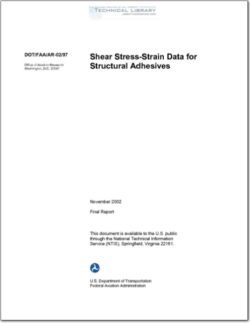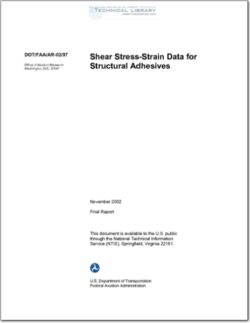DOT-FAA-AR-01-97

- Version
- 224 Downloads
- 1.62 MB File Size
- 1 File Count
- March 23, 2016 Create Date
- March 23, 2016 Last Updated
Stress Strain Data for Structural Adhesives

The main objective of this investigation was to generate characteristic shear responses for several
adhesives used for aerospace structural bonding applications. The shear responses consisted of
shear stress-strain curves obtained by standardized tests and characterizing subsequent failure
modes at three different environmental conditions. Six of these adhesives were film and the
remaining were paste adhesive. In addition, the effects of heat and humidity on the apparent
shear strength, shear modulus, and failure modes of each adhesive were investigated by testing at
elevated temperatures with humidity-conditioned specimens. The characteristic shear responses
were generated using the ASTM D 5656 thick adherend test method. The primary purpose of
this report was to make this data available for use in future design and modeling efforts.
The main objective of this investigation was to generate characteristic shear responses for several
adhesives used for aerospace structural bonding applications. This task involved generating
characteristic shear stress-strain data at three different environmental conditions: room
temperature dry (RTD), elevated temperature dry (ETD), and elevated temperature wet (ETW).
This study generated characteristic shear responses for 18 different adhesive systems that are
currently being investigated for use in manufacturing applications, as well as several that have
been used historically in aircraft primary structural bonding. Six of these adhesives were film
and the remaining were paste. In addition, the effects of heat and humidity on the apparent shear
strength, shear modulus, and failure modes of each adhesive were investigated.
The motivation for this study was the increased use of adhesive bonding in construction of
general aviation aircraft. Additional impetus was to study the effects of elevated temperature on
adhesive behavior as lower cure temperature (than previous military applications) is being used
in such constructions. The adhesive strength and modulus were determined according to ASTM
D 5656 (Standard Test Method for Thick-Adherend Metal Lap-Shear Joints for Determination of
the Stress—Strain Behavior of Adhesives in Shear by Tension Loading [1]). Testing was
conducted in three different environmental conditions: RTD, ETD (~180°F), and BTW
(~1800F). The substrate material, provided by Cessna Aircraft Company of Wichita, Kansas,
was phosphorically anodized 2024-T3 aluminum.
| File | Action |
|---|---|
| 1458755302wpdm_DOT-FAA-AR-01-97 Stress Strain Data for Structural Adhesives.pdf | Download |
Comment On This Post